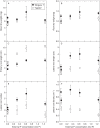High-throughput root phenotyping screens identify genetic loci associated with root architectural traits in Brassica napus under contrasting phosphate availabilities
- PMID: 23172414
- PMCID: PMC3698377
- DOI: 10.1093/aob/mcs245
High-throughput root phenotyping screens identify genetic loci associated with root architectural traits in Brassica napus under contrasting phosphate availabilities
Abstract
Background and aims: Phosphate (Pi) deficiency in soils is a major limiting factor for crop growth worldwide. Plant growth under low Pi conditions correlates with root architectural traits and it may therefore be possible to select these traits for crop improvement. The aim of this study was to characterize root architectural traits, and to test quantitative trait loci (QTL) associated with these traits, under low Pi (LP) and high Pi (HP) availability in Brassica napus.
Methods: Root architectural traits were characterized in seedlings of a double haploid (DH) mapping population (n = 190) of B. napus ['Tapidor' × 'Ningyou 7' (TNDH)] using high-throughput phenotyping methods. Primary root length (PRL), lateral root length (LRL), lateral root number (LRN), lateral root density (LRD) and biomass traits were measured 12 d post-germination in agar at LP and HP.
Key results: In general, root and biomass traits were highly correlated under LP and HP conditions. 'Ningyou 7' had greater LRL, LRN and LRD than 'Tapidor', at both LP and HP availability, but smaller PRL. A cluster of highly significant QTL for LRN, LRD and biomass traits at LP availability were identified on chromosome A03; QTL for PRL were identified on chromosomes A07 and C06.
Conclusions: High-throughput phenotyping of Brassica can be used to identify root architectural traits which correlate with shoot biomass. It is feasible that these traits could be used in crop improvement strategies. The identification of QTL linked to root traits under LP and HP conditions provides further insights on the genetic basis of plant tolerance to P deficiency, and these QTL warrant further dissection.
Keywords: Brassica napus; Phosphate; QTL; biomass; genetic; heritability; oilseed rape; phosphorus; root.
Figures


Similar articles
-
A novel Brassica-rhizotron system to unravel the dynamic changes in root system architecture of oilseed rape under phosphorus deficiency.Ann Bot. 2016 Aug;118(2):173-84. doi: 10.1093/aob/mcw083. Epub 2016 Jun 8. Ann Bot. 2016. PMID: 27279575 Free PMC article.
-
Rapid identification of a major locus qPRL-C06 affecting primary root length in Brassica napus by QTL-seq.Ann Bot. 2023 Apr 28;131(4):569-583. doi: 10.1093/aob/mcac123. Ann Bot. 2023. PMID: 36181516 Free PMC article.
-
QTL meta-analysis of root traits in Brassica napus under contrasting phosphorus supply in two growth systems.Sci Rep. 2016 Sep 14;6:33113. doi: 10.1038/srep33113. Sci Rep. 2016. PMID: 27624881 Free PMC article.
-
Genetic dissection of root morphological traits as related to potassium use efficiency in rapeseed under two contrasting potassium levels by hydroponics.Sci China Life Sci. 2019 Jun;62(6):746-757. doi: 10.1007/s11427-018-9503-x. Epub 2019 May 5. Sci China Life Sci. 2019. PMID: 31069628 Review.
-
Enhancing phosphorus and zinc acquisition efficiency in rice: a critical review of root traits and their potential utility in rice breeding.Ann Bot. 2013 Jul;112(2):331-45. doi: 10.1093/aob/mcs217. Epub 2012 Oct 15. Ann Bot. 2013. PMID: 23071218 Free PMC article. Review.
Cited by
-
Genetic dissection of the shoot and root ionomes of Brassica napus grown with contrasting phosphate supplies.Ann Bot. 2020 Jun 19;126(1):119-140. doi: 10.1093/aob/mcaa055. Ann Bot. 2020. PMID: 32221530 Free PMC article.
-
Matching roots to their environment.Ann Bot. 2013 Jul;112(2):207-22. doi: 10.1093/aob/mct123. Ann Bot. 2013. PMID: 23821619 Free PMC article.
-
High-Throughput Root Imaging Analysis Reveals Wide Variation in Root Morphology of Wild Adzuki bean (Vigna angularis) Accessions.Plants (Basel). 2022 Feb 1;11(3):405. doi: 10.3390/plants11030405. Plants (Basel). 2022. PMID: 35161386 Free PMC article.
-
Temporal genetic patterns of root growth in Brassica napus L. revealed by a low-cost, high-efficiency hydroponic system.Theor Appl Genet. 2019 Aug;132(8):2309-2323. doi: 10.1007/s00122-019-03356-7. Epub 2019 May 17. Theor Appl Genet. 2019. PMID: 31101925
-
Genome-Wide Association Studies of Root-Related Traits in Brassica napus L. under Low-Potassium Conditions.Plants (Basel). 2022 Jul 12;11(14):1826. doi: 10.3390/plants11141826. Plants (Basel). 2022. PMID: 35890461 Free PMC article.
References
-
- Abramoff MD, Magelhaes PJ, Ram SJ. Image processing with ImageJ. Biophotonics International. 2004;11:36–42.
-
- Akhtar MS, Oki Y, Adachi T. Genetic variability in phosphorus acquisition and utilisation efficiency from sparingly soluble P-sources by Brassica cultivars under P-stress environment. Journal of Agronomy and Crop Science. 2008;194:380–392.
-
- Al-Ghazi Y, Muller B, Pinloche S, et al. Temporal responses of Arabidopsis root architecture to phosphate starvation: evidence for the involvement of auxin signalling. Plant, Cell & Environment. 2003;26:1053–1066.
-
- Barber SA. Soil nutrient bioavailability: a mechanistic approach. New York: Wiley; 1995.
-
- Bates TR, Lynch JP. Stimulation of root hair elongation in Arabidopsis thaliana by low phosphorus availability. Plant, Cell & Environment. 1996;19:529–538.
Publication types
MeSH terms
Substances
LinkOut - more resources
Full Text Sources
Research Materials
Miscellaneous

